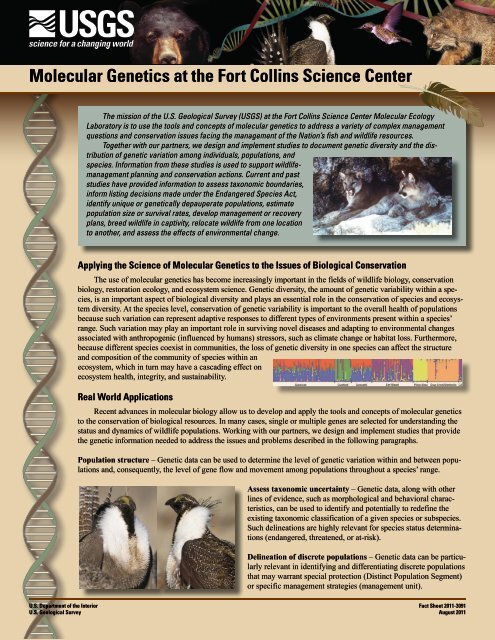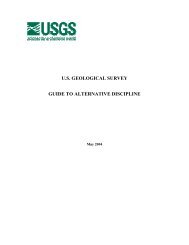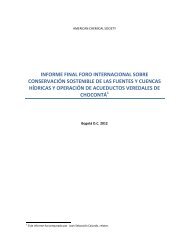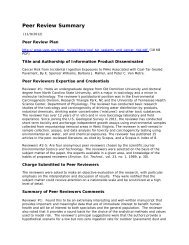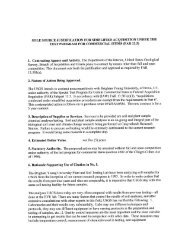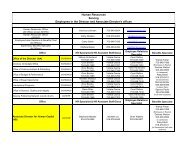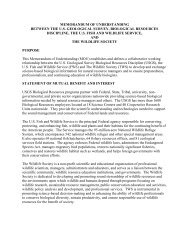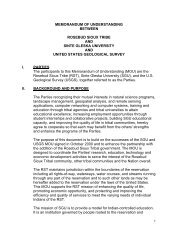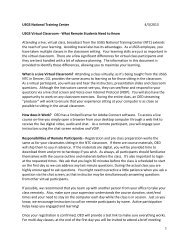Fort Collins Molecular Genetics Fact Sheet - USGS
Fort Collins Molecular Genetics Fact Sheet - USGS
Fort Collins Molecular Genetics Fact Sheet - USGS
You also want an ePaper? Increase the reach of your titles
YUMPU automatically turns print PDFs into web optimized ePapers that Google loves.
<strong>Molecular</strong> <strong>Genetics</strong> at the <strong>Fort</strong> <strong>Collins</strong> Science Center<br />
The mission of the U.S. Geological Survey (<strong>USGS</strong>) at the <strong>Fort</strong> <strong>Collins</strong> Science Center <strong>Molecular</strong> Ecology<br />
Laboratory is to use the tools and concepts of molecular genetics to address a variety of complex management<br />
questions and conservation issues facing the management of the Nation’s fish and wildlife resources.<br />
Together with our partners, we design and implement studies to document genetic diversity and the distribution<br />
of genetic variation among individuals, populations, and<br />
species. Information from these studies is used to support wildlifemanagement<br />
planning and conservation actions. Current and past<br />
studies have provided information to assess taxonomic boundaries,<br />
inform listing decisions made under the Endangered Species Act,<br />
identify unique or genetically depauperate populations, estimate<br />
population size or survival rates, develop management or recovery<br />
plans, breed wildlife in captivity, relocate wildlife from one location<br />
to another, and assess the effects of environmental change.<br />
Applying the Science of <strong>Molecular</strong> <strong>Genetics</strong> to the Issues of Biological Conservation<br />
The use of molecular genetics has become increasingly important in the fields of wildlife biology, conservation<br />
biology, restoration ecology, and ecosystem science. Genetic diversity, the amount of genetic variability within a species,<br />
is an important aspect of biological diversity and plays an essential role in the conservation of species and ecosystem<br />
diversity. At the species level, conservation of genetic variability is important to the overall health of populations<br />
because such variation can represent adaptive responses to different types of environments present within a species’<br />
range. Such variation may play an important role in surviving novel diseases and adapting to environmental changes<br />
associated with anthropogenic (influenced by humans) stressors, such as climate change or habitat loss. Furthermore,<br />
because different species coexist in communities, the loss of genetic diversity in one species can affect the structure<br />
and composition of the community of species within an<br />
ecosystem, which in turn may have a cascading effect on<br />
ecosystem health, integrity, and sustainability.<br />
Real World Applications<br />
Recent advances in molecular biology allow us to develop and apply the tools and concepts of molecular genetics<br />
to the conservation of biological resources. In many cases, single or multiple genes are selected for understanding the<br />
status and dynamics of wildlife populations. Working with our partners, we design and implement studies that provide<br />
the genetic information needed to address the issues and problems described in the following paragraphs.<br />
Population structure – Genetic data can be used to determine the level of genetic variation within and between populations<br />
and, consequently, the level of gene flow and movement among populations throughout a species’ range.<br />
Assess taxonomic uncertainty – Genetic data, along with other<br />
lines of evidence, such as morphological and behavioral characteristics,<br />
can be used to identify and potentially to redefine the<br />
existing taxonomic classification of a given species or subspecies.<br />
Such delineations are highly relevant for species status determinations<br />
(endangered, threatened, or at-risk).<br />
Delineation of discrete populations – Genetic data can be particularly<br />
relevant in identifying and differentiating discrete populations<br />
that may warrant special protection (Distinct Population Segment)<br />
or specific management strategies (management unit).<br />
U.S. Department of the Interior<br />
U.S. Geological Survey<br />
<strong>Fact</strong> <strong>Sheet</strong> 2011-3091<br />
August 2011
Assess environmental change – With advancing genomic technology, it is now possible<br />
to locate and to assess genes that may be directly involved in a species’ ability to<br />
respond to environmental change (for example, climate change).<br />
Landscape genetics – Genetic data can be used in conjunction with landscape data<br />
(for example, habitat, elevation, roads) to identify landscape features that function as<br />
barriers to movement for species.<br />
Assess family relations/mating system – Genetic data can be used to investigate mating systems and parentage, and<br />
evaluate how these data may influence effective population size, the number of individuals in a<br />
population that actually contributes genes to succeeding generations.<br />
Population modeling – Genetic data can be used in population models for predicting the<br />
potential effects of different management scenarios (for example, fertility control) on genetic<br />
diversity of managed populations.<br />
Captive breeding and reintroduction/translocations – Genetic data can be used to inform<br />
captive breeding, reintroduction, and translocation programs to ensure that genetic diversity is<br />
maximized, or to ensure that when moving animals from one location to another, the genetic<br />
makeup of the individual or the population is considered.<br />
Estimate population size and survival rates – DNA from non-invasively sampled individuals<br />
(using feathers, feces, or hair, for example) can be used as a molecular tag and analyzed with<br />
traditional mark-recapture techniques to estimate population size and survival rates.<br />
Gender identification – Genetic data can be used to identify the gender of an individual when morphological or<br />
behavioral characteristics between males and females are indistinguishable.<br />
Species identification – <strong>Molecular</strong> genetics tests can<br />
be used to identify the species and somtimes even<br />
the population of origin from a sample (feather, tissue,<br />
feces, hair) of unknown origin.<br />
For Further Information<br />
For inquiries about science capabilities, research, services, or partnership opportunities, please see our<br />
website http://www.fort.usgs.gov/MEL/ or contact:<br />
Principal Investigator<br />
Sara Oyler-McCance<br />
Research Geneticist<br />
Phone: 970-226-9197<br />
Email: soyler@usgs.gov<br />
Laboratory Address:<br />
<strong>Fort</strong> <strong>Collins</strong> Science Center<br />
2150 Centre Avenue, Bldg C<br />
<strong>Fort</strong> <strong>Collins</strong>, CO 80526-8118<br />
Laboratory Manager<br />
Jennifer Fike<br />
Geneticist<br />
Phone: 970-226-9199<br />
Email: fikej@usgs.gov<br />
For further information on genetics research and capabilities<br />
within the U.S. Geological Survey, visit the <strong>USGS</strong> <strong>Genetics</strong><br />
and Genomics website at<br />
http://ecosystems.usgs.gov/genetics_genomics/<br />
Photos: Front page, American Black Bear (U.S. Fish and Wildlife Service, Waverley Traylor), Greater Sage-grouse (U.S. Fish and Wildlife Service, Stephen Ting), Broad-tailed<br />
Hummingbird (Bill Ratcliff), Lynx (U.S. Fish and Wildlife Service, Erwin and Peggy Bauer), Mountain Lions (U. S. Fish and Wildlife Service), Gunnison Sage-grouse (Gerrit Vyn), Greater<br />
Sage-grouse (Stephen Ting, U. S. Fish and Wildlife Service); Back page, Trumpeter Swans (Donna Dewhurst, U.S. Fish and Wildlife Service), Wild Horse (Marty Felix), Greater Sagegrouse<br />
tail feathers (Stephen Ting, U.S. Fish and Wildlife Service), Bat guano in petri dish (Ernie Valdez), Indiana Bat (Susi von Oettingen), <strong>Molecular</strong> Ecology Laboratory (Dean Biggins),<br />
Midget Faded Rattlesnake (Josh Parker).


